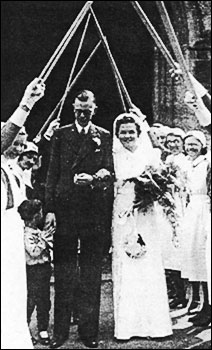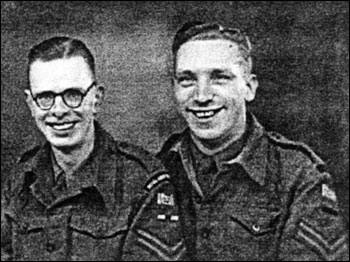| Written by Stan Simons 1999, reproduced by kind permission of his daughter Diana Glasspool. |
||||||
|
||||||
There was no point in having a car to take her to the wedding, so she walked over the road with her dad, and I still have a picture to prove it. My best man was a George Wright and on my stag night him, and one or two other friends, plied me with drink. When I managed to get to the bus stop to take me home to The Rev. Sharpley married us and when we went to sign the register he said to Mary, "Here you are my dear," and gave her back the seven and sixpence which I had given him originally. He was a friend to the family and it was his wedding present. Mary being in her white bridal gown of course hadn't got a pocket so she gave it back to me. I never gave her it back and someone worked out that this is worth more than £200 today. Our wedding reception was held at the Conservative Club, Burton Latimer. My dad provided the band for the music (no disc jockeys in those days), and a good time was had by all. Before going on our honeymoon, in After that terrible winter of 1939/1940 I went to Northampton Recruiting Office and volunteered to receive the King's shilling. Given the "Full Monty" by the medical officer I was graded B3, because of my bad eyesight. I asked to join the R.A.F. but was told the only positions available were as a cook. I found out later that this wasn't true as a friend of mine took up this offer but was never made a cook. It was just a ploy to get you to join the army. On the 4th September 1940 I joined the Royal Army Pay Corps, as a private soldier, and posted to the Pay Office at I was posted to Eventually we stayed with Mary's sister Helen, and her husband Henry. Helen worked in a cake shop and used to come home, after work, with any stale cake left over from the day. Our pudding nearly every day was stale cake with custard on it. Early summer 1941 I was given leave so Mary and I took the train to Torquay for a week's stay. At that time any soldier travelling had to be in uniform but could wear civvies on reaching their destination. The hotel we had booked at Torquay was pretty high class; they even had their own farm so there was very good food. When we arrived I went into the cloakroom and there, hanging up on pegs, was all these uniforms and hats, decorated with gold braid, wing commanders, squadron leaders and such like. There was me a humble lance-corporal, I just couldn't get rid of my uniform quickly enough. Actually they were all veterans, mostly airmen from the First World War. They were all instructors in the air force and as we got to know them very pleasant and friendly. There was also a high court judge from
As I was due to leave the Army they tried to persuade me to join up as a regular. In the R.A.P.C. there was a system of automatic promotion. If I remember correctly after two years service you were promoted to Corporal. Then after another three years Lance-Sergeant, another three years full Sergeant. You were then put on a list and as you reached the top promoted to Staff Sergeant. Again another three years to W02 Quarter Master Sergeant. The only true rank you had to earn on your merits was to W01 Staff Sergeant Major. I resisted both temptations, although having completed nearly six year's service this would have counted towards any regular rank. I wondered for a long time afterwards if I did right by going back to United Counties. I was also asked if I wished to become a schoolteacher. I suppose they were short of men teachers after the War. De-mobbed in June 1946, with an exemplary character reference I went back to United Counties, starting at £5 12s 6p per week after getting about £9 a week, with pay and allowances, in the army. |
||||||
|
||||||

